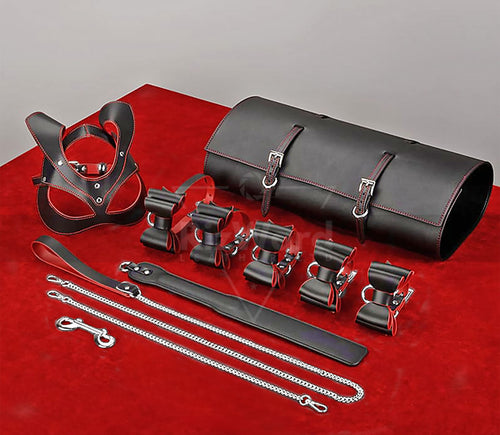The Real Reasons Why People Like BDSM
In the world of human sexuality, few topics carry as much intrigue and misunderstanding as BDSM. From whispers behind closed doors to mainstream cultural references, BDSM has slowly shifted from taboo to curiosity. But one question continues to echo—why do people like BDSM?
The answer lies in a complex mix of psychology, biology, trust, sensation, and personal preference. This guide will explore the truth behind the desire for power exchange, sensation play, and emotional depth within BDSM relationships, all while staying informative, user-friendly, and completely natural in tone.
Understanding BDSM: More Than Just an Acronym

BDSM stands for Bondage and Discipline, Dominance and Submission, Sadism and Masochism. These practices range from light spanking and roleplay to more intense acts like sensory deprivation or control. At its core, BDSM is about consensual power exchange, emotional connection, and physical experience.
Many people assume BDSM is about pain, but in reality, it is often about sensation, control, and trust. Even soft activities like restraint with silk scarves or slow teasing can fall under the BDSM umbrella.
What Is a Kink? Understanding Sexual Exploration

A kink is any non-traditional sexual interest. That might include roleplay, fetishes, or using specific tools like cuffs or blindfolds. Kinks vary greatly, but they all share a common goal—enhancing connection and pleasure.
Unlike clinical fetishes, which are medically defined, kinks exist on a spectrum. BDSM is one of the most common sexual kinks in the world, practiced by people of all genders, orientations, and backgrounds.
Psychological Reasons: The Brain on BDSM
So, why do people like BDSM from a psychological perspective? Research shows that certain BDSM activities trigger endorphins and adrenaline, leading to heightened pleasure, euphoria, and bonding.
-
Role clarity: In a world full of uncertainty, BDSM offers clearly defined roles—dominant and submissive—that create emotional safety.
-
Trust building: Letting someone tie you up or control your pleasure requires deep trust. This vulnerability can deepen intimacy.
-
Escape: For many, BDSM is a mental escape—a way to shut out the world and enter a private, sacred space.
The Dominant and Submissive Dynamic

A dominant-submissive (D/s) relationship isn't about one partner being more powerful; it's about an agreed-upon dynamic that both parties enjoy. The dominant provides structure and control. The submissive willingly yields authority in ways that feel liberating.
A dominant relationship can exist inside or outside the bedroom. Some couples incorporate rules and rituals into their daily life, creating a rhythm that promotes accountability and connection.
Brat BDSM: The Tease Within Submission

Not every submissive is quiet and compliant—some playfully rebel. In brat BDSM, the submissive intentionally misbehaves to provoke a reaction from their Dominant, craving the attention and correction that follow. It’s not about disrespect, but rather a charged, flirtatious form of power exchange.
Managing a brat often involves creative structure. Tools like a leather harness can be essential—not only as a form of restraint but as a symbol of control, helping the brat feel both secure and desired.

These dynamics rely on strong communication, clear limits, and a mutual appreciation for the push and pull of dominance and playful resistance.
Who Are the Participants? Girl BDSM, Men in Control, and Beyond

BDSM is not gender-specific. People across the spectrum engage in this kind of play. Some explore girl BDSM scenes, where a submissive female is guided by a caring dominant. Others find strength in BDSM male roles, relishing their ability to lead and protect.

In many D/s relationships, the role is not fixed to gender but to preference and personality. Some BDSM women are dominants. Some men identify as submissives. It’s a dance of power, not identity.
What Is a Rigger in a Relationship?

A rigger BDSM is someone who ties up a partner—often in artistic or strategic ways—as part of bondage play. The term originates from rope bondage, where tension and pattern play create both aesthetic and physical sensation.
If you've ever heard the term rigger meaning BDSM, it refers to someone who takes the dominant rope-based role, often with intense focus on safety and care.
Exploring BDSM Rooms and Spaces

A BDSM room—sometimes called a dungeon—is a space specifically set up for BDSM activities. It may include furniture like spanking benches, crosses, slings, or cages. These rooms are not just about intensity—they're about control, ritual, and intention.
Whether you're new or experienced, having a designated space helps set the mood and manage expectations.
Is It All About Pain? Erotic BDSM and Pleasure
Not at all. While erotic BDSM can involve spanking or other intense sensations, it's always consensual and often pleasurable. Medical BDSM, for example, might involve clinical roleplay or tools, but it's more about psychological arousal than discomfort.
Others explore heavy fetish experiences like sensory play, objectification, or role reversal. Again, the core element is always mutual consent and clear communication.
Can BDSM Be Forced? Understanding Boundaries
Some fantasize about forced BDSM or torture scenarios, but in practice, these are controlled scenes with safewords and mutual planning. No one is ever truly "forced" in ethical BDSM. It's roleplay, not reality.

The fantasy of being forced to BDSM is about relinquishing control in a safe, consensual space—not actual coercion.
The Rules of the Game: Consent, Communication, and Aftercare
BDSM rules are essential. They can be written or verbal, but they set the tone for respectful play. Common rules include:
-
Using safewords like "yellow" and "red"
-
Establishing physical limits
-
Offering emotional aftercare post-scene
Good communication before, during, and after play is essential.
Symbols and Signals: The BDSM Identity
The BDSM symbol—a triskele inside a circle—is used by many to identify their interest in kink. Wearing it as a pendant or marking can signal your preferences discreetly.
Online communities often use terms like "Dom", "sub", or "switch" to help people connect with compatible partners.
How to Be Dominant in Bed: Tips for New Doms

Being dominant isn't about aggression. It's about attentiveness, confidence, and care. Start small:
-
Give clear, calm instructions
-
Use props like bondage cuffs or blindfolds
-
Pay close attention to your partner's responses
Always check in emotionally. Dominance should never override consent.
Embracing BDSM in Long-Term Relationships
Incorporating BDSM into ongoing relationships takes time and openness. Here’s how:
-
Explore fantasies together
-
Introduce kink gradually
-
Use tools like restraints, collars, or spanking paddles
Products like those at Rizwards Leather can help couples discover new layers of connection. Our handcrafted gear is designed for safety, comfort, and aesthetic appeal.

Over time, kink can become a powerful emotional and physical language in your relationship.
Final Thoughts: Why People Like BDSM
People enjoy BDSM for many reasons:
-
Deepened trust and connection
-
A safe space for vulnerability and power play
-
Heightened physical and emotional pleasure
It's not about being broken or strange—it's about being curious, consensual, and connected.
Whether you’re exploring your first scene or living a full-time D/s dynamic, BDSM can be a deeply enriching part of your intimate life.
If you're looking to explore safely, ethically, and pleasurably, trust your instincts—and find quality tools. Explore expertly crafted Leather Restraints and VIP Sling at Rizwards Leather, where your fantasies meet precision and care.

FAQs
Q: What is BDSM exactly?
A: BDSM stands for bondage, discipline, dominance, submission, sadism, and masochism. It’s a form of consensual erotic play and emotional connection.
Q: Is BDSM always about pain?
A: No. It’s more about power, sensation, and trust. Many scenes are entirely pain-free.
Q: How do I start exploring BDSM safely?
A: Communicate openly, start slow, establish safewords, and use high-quality, body-safe gear.
Q: What is a BDSM room?
A: A designated space for BDSM activities. It often includes furniture and tools for various types of play.
Q: What’s a rigger?
A: Someone who ties up their partner in rope bondage, focusing on safety, comfort, and connection.










POST COMMENTS